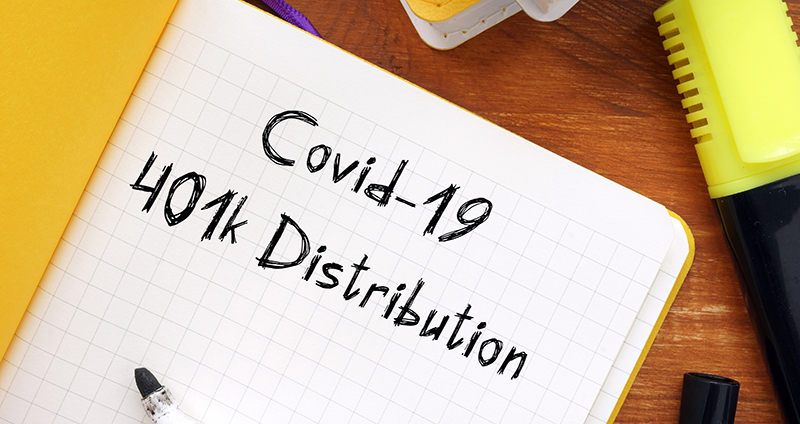Coronavirus Financial Hardship Withdrawal from 401(k) Plans
March, 16 2021 by Carolyn Richardson, EA, MBA
If you’ve been laid off because of the coronavirus crisis like so many other Americans, you may have looked at your 401(k) plan with a gleaming eye as a way to make ends meet during these financially difficult times. However, the tax consequences of taking money out of your retirement plan might have stopped you from taking the withdrawal, even in dire financial circumstances. After all, why create tax problems later? But is there a way to withdraw some funds from these plans to help tide you over because of coronavirus? The CARES Act implemented several exceptions to the rules regarding retirement distributions, withdrawals, and early distribution penalties. The aim of these provisions was to allow taxpayers to access retirement funds if they found themselves in financial difficulties due to coronavirus-related illnesses or unemployment.
Under the CARES Act, you can receive a “qualified coronavirus-related distribution” from your retirement plan and avoid the 10% penalty on early distributions. You may recall that the IRS has offered this kind of relief from the penalty on distributions due to other types of disasters, such as hurricanes or wildfires. However, keep in mind that the relief provision on the 10% early distribution penalty does not apply to the income taxes that would be due on the distribution. Because the money was put into your 401(k) on a tax-deferred basis, the income taxes are due on those funds when you distribute the money from these accounts. Also, while many employer plans permit employees to receive financial hardship distributions, not all of them do – so you should check with your employer to see if these distributions are permitted in your plan.
How much money from your 401(k) can you withdraw?
The total amount of your coronavirus-related distributions that you can receive cannot exceed $100,000 from all plans. This means that you can take some money from both an IRA account and your 401(k). However, if you take money from your 401(k), your employer may not know if you have taken money from another retirement account. Keep in mind that it is not your employer’s responsibility to determine if you have exceeded the limits; that is something you must determine yourself. For example, if I have $200,000 in a Traditional IRA account and a 401(k) at work, I can take $50,000 from the IRA and then another $50,000 from my current employer’s 401(k) plan. Or, I can take $100,000 just from my IRA account and nothing from my employer’s 401(k) plan and vice versa, taking $100,000 from my employer’s 401(k) plan and nothing from the IRA. Withdrawals greater than $100,000 will be treated as excess withdrawals and subject to the 10% early withdrawal penalty.
What about a 457(b) plan?
You might be saying to yourself, “That’s great, but my employer doesn’t have a 401(k) plan; we have a 457(b) plan.” The good news is that even these types of plans will qualify. You can take a qualified distribution from an IRA account or any qualified employer-sponsored retirement plan, such as a 401(k) plan, a 403(a) plan, a 403(b) plan, or a 457(b) plan. It does not apply to defined contribution plans (such as pensions) but does apply to money purchase plans.
What is considered a qualified distribution?
To be considered a qualified distribution, the distribution must happen on or after March 27, 2020, and before December 31, 2020. You must be a “qualified individual.” To be a qualified individual, either you, your spouse, or a member of your household must be diagnosed with SARS-CoV-2 or COVID-19, and you must have experienced “adverse financial consequences” as a result of the coronavirus.
Adverse financial consequences include any of the following:
- Being quarantined;
- Being furloughed or laid off or having work hours reduced due to the virus or disease;
- Being unable to work due to lack of childcare due to the virus or disease;
- Closing or reducing hours for a business owned or operated by the individual due to the virus or disease;
- Suffering a reduction in pay (or self-employment income) due to COVID-19 or having a job offer rescinded or start date for a job delayed due to COVID-19;
- The individual’s spouse or household member is being quarantined, being furloughed or laid off, or having work hours reduced due to COVID-19, being unable to work due to lack of childcare due to COVID-19, or having a job offer rescinded or start date for a job delayed due to COVID-19; or
- Closing or reducing hours of a business owned or operated by the individual’s spouse or household member due to COVID-19.
Including the Distribution in Income
Unlike most withdrawals from a retirement plan, which must be included in your income in the year you make the withdrawal, coronavirus-related distributions are included in income over three years, beginning with the year of distribution. So one-third of the distribution is included in income in 2020, another one-third in your 2021 return, and another one-third in your 2022 return. You can also elect to include the distribution in income in full for the year of distribution. These distributions are reported on Form 8915-E, Qualified 2020 Disaster Retirement Plan Distributions and Repayments, not the Form 5329 which is used for other types of early distributions.
You should carefully consider which option works best for you. If you have federal or state withholding taken from the distribution, that withholding cannot be spread over three years to match the income inclusion. If spreading the income over three years results in a large refund, you should apply some of the refund to future estimated tax payments for the next tax year. On the other hand, including all of the distribution in income in one year may disqualify you from other tax benefits, such as certain tax credits that have income limitations.
Another option to avoid taxes on the distribution is to recontribute the distribution amount to an eligible retirement plan within three years of receiving it. The amount you redeposit will be treated as though it was an eligible rollover. You do not need to redeposit the amount into the same plan that you took the money from. For example, if you withdraw the money from an employer’s 401(k) plan, you can redeposit the money into your traditional IRA account. Distributions received as part of a required minimum distribution are not eligible to be recontributed.
If you pass away before the amount is recontributed, the amount is included in your estate income. If your spouse is the beneficiary of the plan, the spouse must include the distribution in their income.
Can I take a loan from my 401(k) to cover living expenses while on furlough?
 Rather than taking a distribution from your employer’s plan, you might want to consider a loan from the plan instead. Loans are not taxable income, and you can generally repay a loan to an employer’s retirement plan over a longer period than three years.
Rather than taking a distribution from your employer’s plan, you might want to consider a loan from the plan instead. Loans are not taxable income, and you can generally repay a loan to an employer’s retirement plan over a longer period than three years.
Like distributions, you must be a “qualified individual” and have suffered adverse financial consequences due to the coronavirus. The qualification rules are the same as explained above for distributions. The maximum amount you can borrow is either $100,000 or 100% of the value of your benefits under the plan (not less than $10,000), whichever is less. Prior to the enactment of this provision, loans from an employer-sponsored retirement plan were limited to the lesser of $50,000 or 50% of the account value.
Repayments on plan loans are also extended. If a qualified individual has a loan repayment due date after March 27, 2020, and before December 31, 2020, the payment due date is extended for one year or, if later, until September 23, 2020, which is 180 days after the date of enactment. Any subsequent repayments are also adjusted, and the normal 5-year repayment period is disregarded. However, if you are permanently laid off or lose your job, the remaining balance of the loan will generally be treated as a distribution to you in the year you are no longer employed by that employer unless you can repay the loan in full within 60 days of your termination. If you are under the age of 59½ when you are terminated, the distribution will be subject to the 10% early distribution penalty.
For purposes of this section, the loan must be made on or after March 27, 2020, and before December 31, 2020.
Because individuals cannot borrow against their IRA accounts, these loan provisions do not apply to IRA accounts. Loans can only be taken against employer-provided plans such as 401(k), 403(b), or 457(b) plans, and the plan must permit employees to take loans against the plan in the plan documents. If you aren’t certain if your employer’s plan allows for loans, check with your employer.





